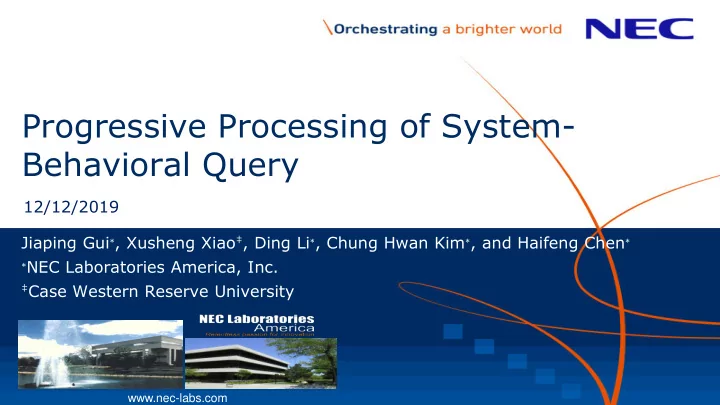

Progressive Processing of System- Behavioral Query 12/12/2019 Jiaping Gui ∗ , Xusheng Xiao ‡ , Ding Li ∗ , Chung Hwan Kim ∗ , and Haifeng Chen ∗ ∗ NEC Laboratories America, Inc. ‡ Case Western Reserve University 1 www.nec-labs.com
Motivation Threat detection and investigation is an important security solution in enterprises Alert Storing Monitoring Investigation Agents Data collector DB Defense 2
Motivation Alert investigation … query revise revise query Process ─ Query 1: select processes that accessed sensitive data in DB ─ Query 2: check whether unsigned program executed probing commands ─ Query 3: get source process that opened/created unsigned program ─ … May take a long execution time 3
Challenges ─ Long waiting time for even a single query • A huge amount of data in DB … > 100GB/200 computers/day • Query multiple hosts’ or multiple days’ data Some advanced attack behaviors may span over several months Check other machines if the same suspicious behaviors exist ─ Making interactive querying difficult … query Searching … revise revise query 4
Challenges Optimize the query execution o > 30% improvement (parallel execution) 1-host query into 4 sub-queries 1-host query into 8 sub-queries Some sub-queries may still take a long time even with optimization o Especially when querying multiple hosts ’/days’ data o Bounded by hardware (bottleneck) Sub-query costs: DB connection, query parsing, thread overhead Hardware limitation: CPU, disk, etc. 5
Insight Partial results are very helpful to make a decision! Process ─ Query 1: select processes that accessed sensitive data in DB ─ Query 2: check whether unsigned program executed probing commands ─ Query 3: get source process that opened/created unsigned program … Pause and revise query when seeing unsigned program 6
Approach Progressive Querying ─ Progressively update results during the execution instead of until the end Results Results Quality metrics 30s Results 20s o Q.1: results updated within the update 10s cycle 30s o Q.2: small overhead on the total ① init execution time … t 1 t 2 t 3 t 2 t 3 t 3 t 1 ④ ② ③ ⑥ ⑤ 7
Progressive Querying: straightforward solutions Naïve solution Whole-query update ─ Partition the query into sub-queries, ─ # sub-queries = # worker each with time window 1s threads • e.g., 1-day query = 3600*24 subqueries ─ 532s (1 worker thread) ─ >28hrs (1 worker thread) ─ 214s (5 worker threads) ─ 6.7hrs (5 worker threads) Q.1: only 1 update Q.1: update fast Q.2: low overhead Q.2: unacceptable overhead More intelligent solutions are desired! Ideal: sub-queries finish exactly before each update cycle • Practical: average finish time is close to update cycle • 8
Progressive Querying Sub-queries Intelligent solutions ─ Query partition • Fixed workload • Fixed time window • Adaptive learning Fixed Strategy: cache mechanism / system dynamics are not considered non-cache o Event processing rate (#events/s): cache >> non cache o Sub- queries’ execution time varies much average time is far from update frequency cache 9
Progressive Querying Adaptive learning spatial & temporal ─ Goal: adjust event processing rate dynamically • Cache • Non-cache ─ Gradient descent algorithm • Learn different event processing rates Reflect the system runtime environment 10
Results: Progressive Querying Comparison ─ Fixed time window ─ Fixed workload ─ Adaptive learning Average sub-query execution time Adaptive learning ─ Closest proximity of average sub-query time to update frequency ─ E.g., with update cycle 10s, if we have 1000 sub-queries to execute, it can save us > 3 hours compared to fixed strategy 11
Results: Progressive Querying Comparison ─ Fixed time window ─ Fixed workload ─ Adaptive learning Adaptive learning ─ Closest proximity of average sub-query time to update frequency ─ Best response rate: result update at each Response rate cycle 12
Results: Progressive Querying Comparison ─ Fixed time window ─ Fixed workload ─ Adaptive learning Overhead Adaptive learning ─ Closest proximity of average sub-query time to update frequency ─ Best response rate: result update at each cycle ─ Comparable overhead 13
Conclusion A systematic approach to optimize query execution on suspicious system behaviors ─ Parallel execution ─ Performance: sequential with cost >= Sequential >= Parallel >= Time window A comprehensive comparison on progressively processing return results ─ Fixed time window (processing rate & data rate) ─ Fixed workload (all hosts/single host) ─ Adaptive (different learning rates) best performance 14
15
www.nec-labs.com
Recommend
More recommend